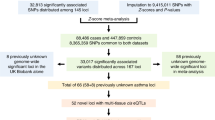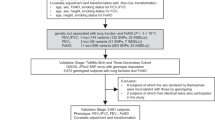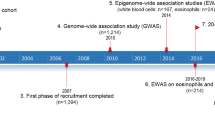Abstract
Sex differences in asthma-associated phenotypes are well known but the genetic factors that may account for these differences have received little attention. This study aimed to characterize sex-specific and pleiotropic genetic factors underlying four quantitative phenotypes involved in the main asthma physiopathological pathways: immunoglobulin E levels, a measure of polysensitization (SPTQ), eosinophil counts and a measure of lung function FEV1/H2 (forced expiratory volume in one second divided by height square). Sex-stratified univariate and bivariate linkage analyses were conducted in 295 families from the Epidemiological study on the Genetics and Environment of Asthma study. We found genome-wide significant evidence for a male-specific pleiotropic QTL (quantitative trait loci) on 5q31 (P=7 × 10−9) influencing both FEV1/H2 and SPTQ and for a female-specific pleiotropic QTL on 11q23 underlying SPTQ and immunoglobulin E (P=2 × 10−5). Three other sex-specific regions of linkage were detected for eosinophil: 4q24 and 22q13 in females, and 3p25 in males. Further, bivariate association analysis of FEV1/H2 and SPTQ with 5q31 candidate genes in males showed a significant association with two single-nucleotide polymorphisms within IL9 gene, rs2069885 and rs2069882 (P=0.02 and P=0.002, respectively, after Bonferroni's correction). This study underlies the importance of taking into account complex mechanisms, such as heterogeneity according to sex and pleiotropy to unravel the genes involved in asthma phenotypes.
This is a preview of subscription content, access via your institution
Access options
Subscribe to this journal
Receive 6 digital issues and online access to articles
$119.00 per year
only $19.83 per issue
Buy this article
- Purchase on Springer Link
- Instant access to full article PDF
Prices may be subject to local taxes which are calculated during checkout
Similar content being viewed by others
References
Weiss LA, Pan L, Abney M, Ober C . The sex-specific genetic architecture of quantitative traits in humans. Nat Genet 2006; 38: 218–222.
Chen Y, Stewart P, Johansen H, McRae L, Taylor G . Sex difference in hospitalization due to asthma in relation to age. J Clin Epidemiol 2003; 56: 180–187.
Becklake MR, Kauffmann F . Gender differences in airway behaviour over the human life span. Thorax 1999; 54: 1119–1138.
Postma DS . Gender differences in asthma development and progression. Gend Med 2007; 4 (Suppl B): S133–S146.
Vercelli D . Discovering susceptibility genes for asthma and allergy. Nat Rev Immunol 2008; 8: 169–182.
Hunninghake GM, Lasky-Su J, Soto-Quiros ME, Avila L, Liang C, Lake SL et al. Sex-stratified linkage analysis identifies a female-specific locus for IgE to cockroach in Costa Ricans. Am J Respir Crit Care Med 2008; 177: 830–836.
Ober C, Pan L, Phillips N, Parry R, Kurina LM . Sex-specific genetic architecture of asthma-associated quantitative trait loci in a founder population. Curr Allergy Asthma Rep 2006; 6: 241–246.
Raby BA, Soto-Quiros ME, Avila L, Lake SL, Murphy A, Liang C et al. Sex-specific linkage to total serum immunoglobulin E in families of children with asthma in Costa Rica. Hum Mol Genet 2007; 16: 243–253.
Marlow AJ, Fisher SE, Francks C, MacPhie IL, Cherny SS, Richardson AJ et al. Use of multivariate linkage analysis for dissection of a complex cognitive trait. Am J Hum Genet 2003; 72: 561–570.
Bouzigon E, Ulgen A, Dizier MH, Siroux V, Lathrop M, Kauffmann F et al. Evidence for a pleiotropic QTL on chromosome 5q13 influencing both time to asthma onset and asthma score in French EGEA families. Hum Genet 2007; 121: 711–719.
Bouzigon E, Dizier MH, Krahenbuhl C, Lemainque A, Annesi-Maesano I, Betard C et al. Clustering patterns of LOD scores for asthma-related phenotypes revealed by a genome-wide screen in 295 French EGEA families. Hum Mol Genet 2004; 13: 3103–3113.
Lander E, Kruglyak L . Genetic dissection of complex traits: guidelines for interpreting and reporting linkage results. Nat Genet 1995; 11: 241–247.
Alcais A, Abel L . Maximum-Likelihood-Binomial method for genetic model-free linkage analysis of quantitative traits in sibships. Genet Epidemiol 1999; 17: 102–117.
Mangin B TP, Grimsley N . Pleiotropic QTL analysis. Biometrics 1998; 54: 88–99.
Ober C, Hoffjan S . Asthma genetics 2006: the long and winding road to gene discovery. Genes Immun 2006; 7: 95–100.
Haagerup A, Bjerke T, Schoitz PO, Binderup HG, Dahl R, Kruse TA . Allergic rhinitis—a total genome-scan for susceptibility genes suggests a locus on chromosome 4q24-q27. Eur J Hum Genet 2001; 9: 945–952.
Daley D, Lemire M, Akhabir L, Chan-Yeung M, He JQ, McDonald T et al. Analyses of associations with asthma in four asthma population samples from Canada and Australia. Hum Genet 2009; 125: 445–459.
Nicolaides NC, Holroyd KJ, Ewart SL, Eleff SM, Kiser MB, Dragwa CR et al. Interleukin 9: a candidate gene for asthma. Proc Natl Acad Sci USA 1997; 94: 13175–13180.
Rosenwasser LJ . Promoter polymorphism in the candidate genes, IL-4, IL-9, TGF-beta1, for atopy and asthma. Int Arch Allergy Immunol 1999; 118: 268–270.
Little FF, Cruikshank WW, Center DM . Il-9 stimulates release of chemotactic factors from human bronchial epithelial cells. Am J Respir Cell Mol Biol 2001; 25: 347–352.
Melen E, Gullsten H, Zucchelli M, Lindstedt A, Nyberg F, Wickman M et al. Sex specific protective effects of interleukin-9 receptor haplotypes on childhood wheezing and sensitisation. J Med Genet 2004; 41: e123.
Baraldo S, Faffe DS, Moore PE, Whitehead T, McKenna M, Silverman ES et al. Interleukin-9 influences chemokine release in airway smooth muscle: role of ERK. Am J Physiol Lung Cell Mol Physiol 2003; 284: L1093–L1102.
Vermeer PD, Harson R, Einwalter LA, Moninger T, Zabner J . Interleukin-9 induces goblet cell hyperplasia during repair of human airway epithelia. Am J Respir Cell Mol Biol 2003; 28: 286–295.
Wang TN, Chen WY, Huang YF, Shih NH, Feng WW, Tseng HI et al. The synergistic effects of the IL-9 gene and environmental exposures on asthmatic Taiwanese families as determined by the transmission/disequilibrium test. Int J Immunogenet 2006; 33: 105–110.
Holroyd KJ, Martinati LC, Trabetti E, Scherpbier T, Eleff SM, Boner AL et al. Asthma and bronchial hyperresponsiveness linked to the XY long arm pseudoautosomal region. Genomics 1998; 52: 233–235.
Almqvist C, Worm M, Leynaert B . Impact of gender on asthma in childhood and adolescence: a GA2LEN review. Allergy 2008; 63: 47–57.
Siroux V, Oryszczyn MP, Varraso R, Le Moual N, Bousquet J, Charpin D et al. Environmental factors for asthma severity and allergy: results from the EGEA study. Rev Mal Respir 2007; 24: 599–608.
Gomez Real F, Svanes C, Bjornsson EH, Franklin KA, Gislason D, Gislason T et al. Hormone replacement therapy, body mass index and asthma in perimenopausal women: a cross sectional survey. Thorax 2006; 61: 34–40.
Troisi RJ, Speizer FE, Willett WC, Trichopoulos D, Rosner B . Menopause, postmenopausal estrogen preparations, and the risk of adult-onset asthma. A prospective cohort study. Am J Respir Crit Care Med 1995; 152: 1183–1188.
Gold DR, Wang X, Wypij D, Speizer FE, Ware JH, Dockery DW . Effects of cigarette smoking on lung function in adolescent boys and girls. N Engl J Med 1996; 335: 931–937.
Mandhane PJ, Greene JM, Sears MR . Interactions between breast-feeding, specific parental atopy, and sex on development of asthma and atopy. J Allergy Clin Immunol 2007; 119: 1359–1366.
Kauffmann F, Dizier MH, Annesi-Maesano I, Bousquet J, Charpin D, Demenais F et al. Epidemiological study of genetic and environmental factors in asthma, bronchial hyperresponsiveness and atopy. Protocol and potential selection bias. Rev Epidemiol Sante Publique 2001; 49: 343–356.
Kauffmann F, Dizier MH, Pin I, Paty E, Gormand F, Vervloet D et al. Epidemiological study of the genetics and environment of asthma, bronchial hyperresponsiveness, and atopy: phenotype issues. Am J Respir Crit Care Med 1997; 156: S123–S129.
Maccario J, Oryszczyn MP, Charpin D, Kauffmann F . Methodologic aspects of the quantification of skin prick test responses: the EGEA study. J Allergy Clin Immunol 2003; 111: 750–756.
Dockery DW, Ware JH, Ferris Jr BG, Glicksberg DS, Fay ME, Spiro III A et al. Distribution of forced expiratory volume in one second and forced vital capacity in healthy, white, adult never-smokers in six US cities. Am Rev Respir Dis 1985; 131: 511–520.
Oryszczyn MP, Bouzigon E, Maccario J, Siroux V, Nadif R, Wright A et al. Interrelationships of quantitative asthma-related phenotypes in the epidemiological study on the genetics and environment of asthma, bronchial hyperresponsiveness, and atopy. J Allergy Clin Immunol 2007; 119: 57–63.
Bouzigon E, Chaudru V, Carpentier AS, Dizier MH, Oryszczyn MP, Maccario J et al. Familial correlations and inter-relationships of four asthma-associated quantitative phenotypes in 320 French EGEA families ascertained through asthmatic probands. Eur J Hum Genet 2004; 12: 955–963.
O'Connell JR, Weeks DE . PedCheck: a program for identification of genotype incompatibilities in linkage analysis. Am J Hum Genet 1998; 63: 259–266.
Wigginton JE, Cutler DJ, Abecasis GR . A note on exact tests of Hardy–Weinberg equilibrium. Am J Hum Genet 2005; 76: 887–893.
Abel L, Muller-Myhsok B . Robustness and power of the maximum-likelihood-binomial and maximum-likelihood-score methods, in multipoint linkage analysis of affected-sibship data. Am J Hum Genet 1998; 63: 638–647.
Sawcer S, Jones HB, Judge D, Visser F, Compston A, Goodfellow PN et al. Empirical genome wide significance levels established by whole genome simulations. Genet Epidemiol 1997; 14: 223–229.
Horvath S, Xu X, Laird NM . The family based association test method: strategies for studying general genotype–phenotype associations. Eur J Hum Genet 2001; 9: 301–306.
Rakovski CS, Xu X, Lazarus R, Blacker D, Laird NM . A new multimarker test for family-based association studies. Genet Epidemiol 2007; 31: 9–17.
Acknowledgements
The study was funded by INSERM, the French Ministry of Higher Education and Research, University of Evry, the French Agency for Environmental and Occupational Health Safety (Afsset-APR-SE-2004), Fondation pour la Recherche Médicale (ACE20061209064), the French National Agency for Research (ANR 05-SEST-020-02/05-9-97 and ANR 06-CEBS-029-02) and the European Commission as part of GABRIEL, a multidisciplinary study to identify the genetic and environmental causes of asthma in the European Community (Contract no. 01896 under the Integrated Programme LSH-2004-1.2.5-1 Post-genomic approaches to understand the molecular bias of asthma aiming at a preventive or therapeutic control).
Author information
Authors and Affiliations
Consortia
Corresponding author
Appendix
Appendix
EGEA cooperative group
Coordination: F Kauffmann; F Demenais (genetics); I Pin (clinical aspects).
Respiratory epidemiology: Inserm U 700, Paris M Korobaeff (Egea1), F Neukirch (Egea1); Inserm U 707, Paris: I Annesi-Maesano; Inserm U 780, Villejuif: F Kauffmann, N Le Moual, R Nadif, MP Oryszczyn; Inserm U 823, Grenoble: V Siroux.
Genetics: Inserm U 393, Paris: J Feingold; Inserm U 535, Villejuif: MH Dizier; Inserm U 946, Paris: E Bouzigon, F Demenais; CNG, Evry: I Gut, M Lathrop.
Clinical centers: Grenoble: I Pin, C Pison; Lyon: D Ecochard (Egea1), F Gormand, Y Pacheco; Marseille: D Charpin (Egea1), D Vervloet; Montpellier: J Bousquet; Paris Cochin: A Lockhart (Egea1), R Matran (now in Lille); Paris Necker: E Paty, P Scheinmann; Paris-Trousseau: A Grimfeld, J Just.
Data and quality management: Inserm ex-U155 (Egea1): J Hochez; Inserm U 780, Villejuif: N Le Moual, C Ravault; Inserm U 946: N Chateigner; Grenoble: J Ferran.
Rights and permissions
About this article
Cite this article
Aschard, H., Bouzigon, E., Corda, E. et al. Sex-specific effect of IL9 polymorphisms on lung function and polysensitization. Genes Immun 10, 559–565 (2009). https://doi.org/10.1038/gene.2009.46
Received:
Revised:
Accepted:
Published:
Issue Date:
DOI: https://doi.org/10.1038/gene.2009.46
Keywords
This article is cited by
-
Transcription factor Foxo1 is essential for IL-9 induction in T helper cells
Nature Communications (2017)
-
A mast cell-ILC2-Th9 pathway promotes lung inflammation in cystic fibrosis
Nature Communications (2017)
-
Identification of QTL affecting resistance/susceptibility to acute Actinobacillus pleuropneumoniae infection in swine
Mammalian Genome (2014)



